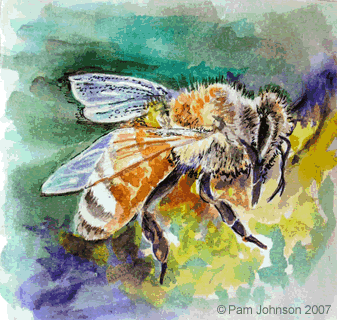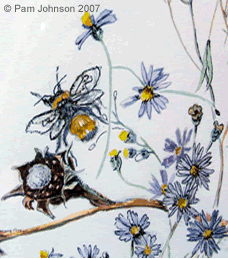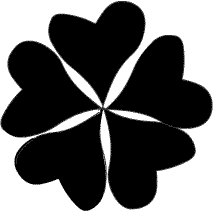Making a Bee-Friendly Garden

Designing a Bee Garden
Inviting an array of bees into your own backyard is simple when you plant their favorite flowers.
By providing nectar and pollen as food and creating shelters in your garden space, you will create new habitat for bees, which is important, as their natural habitats become less and less abundant. Researchers have found that planting bee-friendly gardens in your community may increase the diversity of bees, even within the concrete-laden urban areas in which many of us reside. That's great news for beespotters!
There are four essential elements for designing a bee garden:
- Choose plants that are best suited for attracting bees in your region
- Limit the use of insecticides that are toxic to bees and other beneficial pollinators
- Provide shelter in your garden from elements such as wind, rain, or cold
- Create habitat for the nest of the pollinator to support the entire life cycle of the pollinator from egg to larva to adult.
Choosing plants that attract bees
Select a variety flowers that are most attractive to bees and will bloom at different times throughout the year for a steady supply of nectar and pollen. The climate in your region, defined by the USDA plant hardiness zone map , will determine which flowers can survive and the timing of their flowering in your garden.
Exotic plants that produce lots of nectar, like butterfly bush, are great for attracting bees and butterflies into your yard, but they often cannot support the entire life cycle of these insects. By opting for native plants, your garden will be attractive to adult bees that are foraging for nectar and pollen, but will also increase native habitat in your area for other wildlife, like caterpillars and birds.
When selecting flowers for your bee garden, it is important to recognize that flowers that employ melittophily, or bee pollination, often share particular traits that make them more attractive to bees. The suite of traits that are used by a flower to attract a specific group of animals as pollinators is called a pollination syndrome. These traits can include color, flower shape and size, the amount of nectar produced and the way pollen is presented.

Limiting the use of insecticides
Limiting the use of insecticides in your garden ensures that bees that you have invited into the garden are not accidentally poisoned by pesticides not intended for them. Native bees are attracted to your garden by the nectar and pollen, but they come into contact with any other chemicals that may be present. High doses of insecticides can kill foraging bees outright. Even low doses can have adverse effects. Low doses of insecticides can disrupt the innate orientation and navigation skills of the foraging bee, causing it to lose its way back to the nest. When the pesticide is brought back to the nest, it will be transferred to nestmates directly or incorporated into the honey, where it can alter the development in larvae into workers and queens, and thereby affect future generations of the colony. Practicing integrated pest management in your garden is the best way to limit the use of insecticides.

Creating habitat for the nest
At first, you may not like the idea of attracting stinging insects into the garden. Keep in mind that stinging is a defensive behavior used for defending the nest against predators. If you have ever watched a bee when it visits a flower, you may have noticed that it is often too busy to even notice you! Foraging bees are happy and curious, moving from one flower to the next, in search of nectar and pollen. They are not looking for a fight.
While most people are not equipped to raise honeybees in their backyard, creating nesting habitats for native bees is surprisingly simple. That's because many native bees make nests in old pieces of wood, cavities or even in the ground. These nests can be easily replicated with a few supplies and tools. The addition of nesting sites for native bees to your garden will intensify your beespotting experience beyond the average gardener. For more information on the construction of nests for wood-nesting, cavity-nesting and ground-nesting bees, check out this fact sheet from the Xerces Society.
Providing shelter from the elements
You do not have to uproot your current garden in order to attract more bees. Flowers that attract bees can be planted between existing flowers or potted and placed throughout your yard. Providing shelter for bees in the garden can be as simple as maintaining a garden full of spaces guarded from the elements. Keep in mind that a wide expanse of green grass or concrete does not offer protection from wind, rain and cold for a foraging bee.
| Flowers | Bee visitors | Color | Season | Origin | Flower type |
|---|---|---|---|---|---|
| Great Blue Lobelia (Campanulaceae) |
|
blue | late summer into fall | native |
|
| Wild Lupine (Fabaceae) |
|
blue | mid to late May | native |
|
| Lead Plant (Fabaceae) |
|
purple | early summer | native |
|
| White Wild Indigo (Fabaceae) | Bumble bees | white | May to July | native |
|
| Partridge Pea (Fabaceae) |
|
yellow | summer to fall | native |
|
| Hardy Ageratum (Asteraceae) |
|
blue | summer to fall | native |
 Round Cluster Round Cluster
|
| Stiff Goldenrod (Asteraceae) |
|
yellow | August to September | native |
|
| Showy Goldenrod (Asteraceae) |
|
yellow | July to September | native |
|
| Coneflower (Asteraceae) |
|
purple | June to October | native |
 Radial Symmetry Radial Symmetry
|
| Wild Bergamot (Lamiaceae) |
|
pink | July to September | native |
 Round Cluster Round Cluster
|
| Columbine (Ranunculaceae) |
|
orange-red | April to May | native |
|
| Horsetail Milkweed (Asclepiadaceae) |
|
white | early to late summer | native |
 Round Cluster Round Cluster
|
| Butterfly-weed (Asclepiadaceae) |
|
yellow-orange | June to August | native |
 Round Cluster Round Cluster
|
| Common Milkweed (Asclepiadaceae) | Long-tongued bees | pink, white | June to August | native |
 Round Cluster Round Cluster
|
| Prairie Milkweed (Asclepiadaceae) |
|
pink | June to July | native |
 Round Cluster Round Cluster
|
| Joe Pye weed (Asteraceae) |
|
mauve pink | July to September | native |
 Round Cluster Round Cluster
|
| White Snakeroot (Asteraceae) |
|
white | September to frost | native |
 Round Cluster Round Cluster
|
| Yellow Giant Hyssop (Lamiaceae) |
|
yellow | July to September | native |
|
| Lesser Calamint (Lamiaceae) | Bumble bees | white | June-October | exotic |
|
Long-tongued bees
- Honey bees
- Bumble bees
- Carpenter bees (Apidae)
- Digger bees (Anthophoridae)
- Leaf-cutting bees (Megachilidae)
Short-tongued bees
- Andrenid bees
- Small Miner bees (Andrenidae)
- Plasterer bees
- Masked or Yellow-faced bees (Colletidae)
- Sweat bees (Halictidae)
Further Reading
Xerces Society for the Conservation of Invertebrates offers free fact sheets and publications for sale about conserving pollinators
Missouri Botanical Garden through the Kemper Center for Home Gardening explains gardening plants from A-Z
Bringing Nature Home: How Native plants Sustain Wildlife in Our Gardens. by Douglas Tallamy. 2007.Timber Press. Portland , Oregon .
